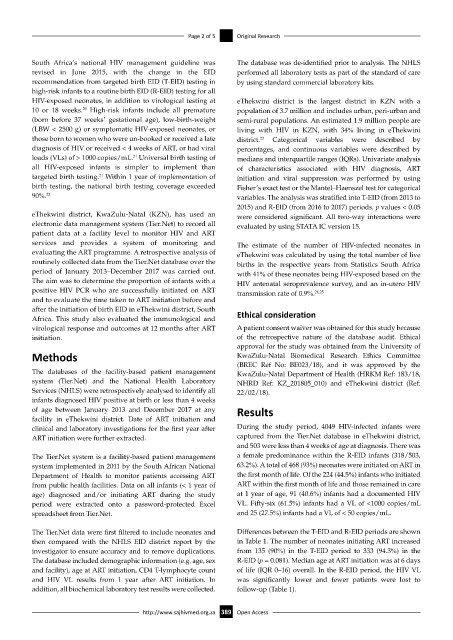Page 397 - HIVMED_v21_i1.indb
P. 397
Page 2 of 5 Original Research
South Africa’s national HIV management guideline was The database was de-identified prior to analysis. The NHLS
revised in June 2015, with the change in the EID performed all laboratory tests as part of the standard of care
recommendation from targeted birth EID (T-EID) testing in by using standard commercial laboratory kits.
high-risk infants to a routine birth EID (R-EID) testing for all
HIV-exposed neonates, in addition to virological testing at eThekwini district is the largest district in KZN with a
10 or 18 weeks. High-risk infants include all premature population of 3.7 million and includes urban, peri-urban and
20
(born before 37 weeks’ gestational age), low-birth-weight semi-rural populations. An estimated 1.9 million people are
(LBW < 2500 g) or symptomatic HIV-exposed neonates, or living with HIV in KZN, with 34% living in eThekwini
those born to women who were un-booked or received a late district. Categorical variables were described by
23
diagnosis of HIV or received < 4 weeks of ART, or had viral percentages, and continuous variables were described by
21
loads (VLs) of > 1000 copies/mL. Universal birth testing of medians and interquartile ranges (IQRs). Univariate analysis
all HIV-exposed infants is simpler to implement than of characteristics associated with HIV diagnosis, ART
21
targeted birth testing. Within 1 year of implementation of initiation and viral suppression was performed by using
birth testing, the national birth testing coverage exceeded Fisher’s exact test or the Mantel–Haenszel test for categorical
90%. 22 variables. The analysis was stratified into T-EID (from 2013 to
2015) and R-EID (from 2016 to 2017) periods. p values < 0.05
eThekwini district, KwaZulu-Natal (KZN), has used an were considered significant. All two-way interactions were
electronic data management system (Tier.Net) to record all evaluated by using STATA IC version 15.
patient data at a facility level to monitor HIV and ART
services and provides a system of monitoring and The estimate of the number of HIV-infected neonates in
evaluating the ART programme. A retrospective analysis of eThekwini was calculated by using the total number of live
routinely collected data from the Tier.Net database over the births in the respective years from Statistics South Africa
period of January 2013–December 2017 was carried out. with 41% of these neonates being HIV-exposed based on the
The aim was to determine the proportion of infants with a HIV antenatal seroprevalence survey, and an in-utero HIV
positive HIV PCR who are successfully initiated on ART transmission rate of 0.9%. 24,25
and to evaluate the time taken to ART initiation before and
after the initiation of birth EID in eThekwini district, South Ethical consideration
Africa. This study also evaluated the immunological and
virological response and outcomes at 12 months after ART A patient consent waiver was obtained for this study because
initiation. of the retrospective nature of the database audit. Ethical
approval for the study was obtained from the University of
Methods KwaZulu-Natal Biomedical Research Ethics Committee
(BREC Ref No: BE023/18), and it was approved by the
The databases of the facility-based patient management KwaZulu-Natal Department of Health (HRKM Ref: 183/18,
system (Tier.Net) and the National Health Laboratory NHRD Ref: KZ_201805_010) and eThekwini district (Ref:
Services (NHLS) were retrospectively analysed to identify all 22/02/18).
infants diagnosed HIV positive at birth or less than 4 weeks
of age between January 2013 and December 2017 at any Results
facility in eThekwini district. Date of ART initiation and
clinical and laboratory investigations for the first year after During the study period, 4049 HIV-infected infants were
ART initiation were further extracted. captured from the Tier.Net database in eThekwini district,
and 503 were less than 4 weeks of age at diagnosis. There was
The Tier.Net system is a facility-based patient management a female predominance within the R-EID infants (318/503,
system implemented in 2011 by the South African National 63.2%). A total of 468 (93%) neonates were initiated on ART in
Department of Health to monitor patients accessing ART the first month of life. Of the 224 (44.5%) infants who initiated
from public health facilities. Data on all infants (< 1 year of ART within the first month of life and those remained in care
age) diagnosed and/or initiating ART during the study at 1 year of age, 91 (40.6%) infants had a documented HIV
period were extracted onto a password-protected Excel VL. Fifty-six (61.5%) infants had a VL of <1000 copies/mL
spreadsheet from Tier.Net. and 25 (27.5%) infants had a VL of < 50 copies/mL.
The Tier.Net data were first filtered to include neonates and Differences between the T-EID and R-EID periods are shown
then compared with the NHLS EID district report by the in Table 1. The number of neonates initiating ART increased
investigator to ensure accuracy and to remove duplications. from 135 (90%) in the T-EID period to 333 (94.3%) in the
The database included demographic information (e.g. age, sex R-EID (p = 0.081). Median age at ART initiation was at 6 days
and facility), age at ART initiation, CD4 T-lymphocyte count of life (IQR 0–16) overall. In the R-EID period, the HIV VL
and HIV VL results from 1 year after ART initiation. In was significantly lower and fewer patients were lost to
addition, all biochemical laboratory test results were collected. follow-up (Table 1).
http://www.sajhivmed.org.za 389 Open Access

